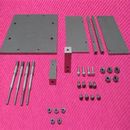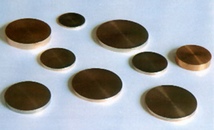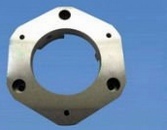Molybdenum alloys



Molybdenum Alloy TZM
TZM alloy (High Temperature Alloy) is the prime alloy of molybdenum. It contains 99.2% min. to 99.5% max. of Mo, 0.50% Ti and 0.08% Zr with a trace of C for carbide formations. TZM offers twice the strength of pure moly at temperatures over 1300°C. The recrystallization temperature of TZM is approximately 250°C higher than moly and it offers better weldability.
The finer grain structure of TZM and the formation of TiC and ZrC in the grain boundaries of the moly inhibit grain growth and the related failure of the base metal as a result of fractures along the grain boundaries. This also gives it better properties for welding. TZM costs approximately 25% more than pure molybdenum and costs only about 5-10% more to machine. For high strength applications such as rocket nozzles, furnace structural components, and forging dies, it can be well worth the cost differential.
TZM is available in sheet and rod form in basically the same size range as moly with the exception of thin foil. Rembar is experienced in the fabrication of TZM. Refer to the separate TZM sheet.
TZM and MoLa Alloys have higher recrystallization temperature, high heat resistance and better creep resistance over pure Mo.
Molybdenum Alloy TZC
Four main classes of commercial molybdenum-base alloys exist. The most common of the carbide-strengthened alloys is known as TZM. Other alloys in this class include TZC (1.2% titanium, 0.3% zirconium, 0.1% carbon), MHC (1.2% hafnium, 0.05% carbon), and ZHM (1.2% hafnium, 0.4% zirconium, 0.12% carbon).
TZC has excellent high temperature strength and high recrystallization temperature, also has a good plasticity at room temperature. Using powder metallurgy and vacuum arc melting method of Preparation. Be in a very bad condition to make a high-temperature structural materials and high-temperature processing of tool materials. As used in the manufacture of aluminum and copper alloys, cast iron and iron-based alloy die-casting molds and cores for stainless steel such as hot extrusion tools and seamless steel pipe thermal processing head. It may also make space rockets flying devices and surface components. Recently, hafnium instead of titanium useful, with the formation of two-phase approach to strengthen the organization of molybdenum alloys.
Copyright©2001 - 2011 CTIA E-biz Center All Rights Reserved
